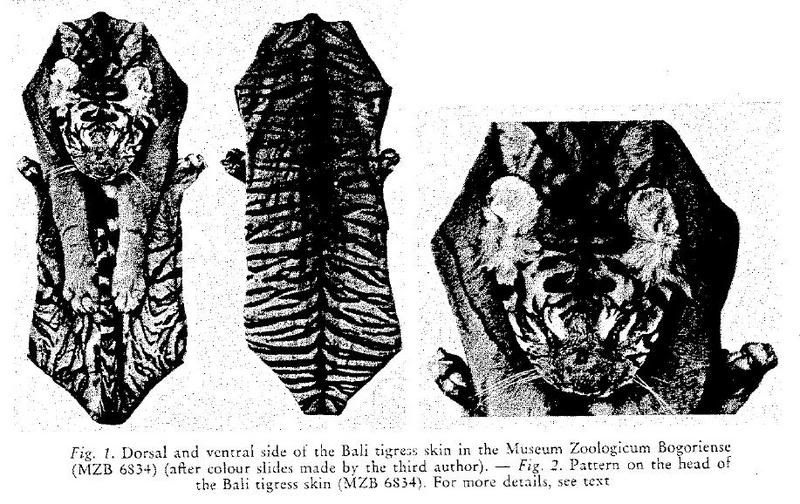|
|
Post by another specialist on May 8, 2007 20:42:25 GMT
Thats the problem with some reference/source some the the info is unreliable and not accurate.
|
|
|
|
Post by sebbe67 on Jul 19, 2007 12:20:59 GMT
|
|
|
|
Post by another specialist on Jul 19, 2007 15:18:33 GMT
|
|
|
|
Post by another specialist on Jul 19, 2007 15:19:08 GMT
Close up of image  |
|
|
|
Post by Melanie on Sept 10, 2007 20:39:02 GMT
|
|
|
|
Post by another specialist on Sept 11, 2007 19:17:26 GMT
|
|
|
|
Post by Peter on Dec 15, 2007 15:39:56 GMT
I was editing some pages on Wikispecies and came across the following: species.wikimedia.org/wiki/Panthera_sondaica>> species.wikimedia.org/wiki/Panthera_sondaica_balica>> species.wikimedia.org/wiki/Panthera_sondaica_sondaicaI found a pdf on this: arts.anu.edu.au/grovco/tiger%20SEAsia%20Mazak.pdfMazak J.H., C.P. Groves. 2006. A taxonomic revision of the tigers (Panthera tigris) of Southeast Asia. Mammalian biology 71, 5:268–287. Deutsche Gesellschaft für Säugetierkunde. AbstractThe taxonomic affinity of Southeast Asian tigers is re-investigated. Specimens of four traditionally recognized subspecies are examined using various craniological methods, including multivariate craniometric and phenetic analysis. Sumatran tigers differ absolutely (100%) from the geographically neighbouring mainland form P.t.corbetti; the Javanese tiger is also 100% distinguishable from the Sumatran. They are therefore regarded as two distinct species ( P.sumatrae, P.sondaica) under the Phylogenetic Species Concept (PSC). The Bali tiger is classified as a subspecies of the Javanese tiger, Panthera sondaica balica. |
|
|
|
Post by another specialist on Dec 15, 2007 19:12:02 GMT
Species: Panthera sondaica Subspecies: †Panthera sondaica balica Panthera sondaica balica (Schwarz, 1912) Type locality: Bali Holotype: SMF 2576, skin and skull of a young adult female [edit] Synonyms Felis tigris balica Schwarz, 1912 Panthera tigris balica (Schwarz, 1912) species.wikimedia.org/wiki/Panthera_sondaica_balica |
|
|
|
Post by another specialist on Dec 15, 2007 19:19:37 GMT
Thanks for the PDF file Peter looking at page 6 with the skull comparision to me personally they look so different from each other? Looking at the Javan and the Bali they look completely different in shape to say they are both subspecies related to each other?
|
|
|
|
Post by Peter on Dec 25, 2007 1:07:40 GMT
Yes, I think genetic research is need to confirm or debunk the results of skull comparison. There is no consensus among scientists on this taxonomic revision as far as I know.
|
|
|
|
Post by another specialist on Dec 25, 2007 13:35:40 GMT
I agree with you Peter more genetic research needed.
|
|
|
|
Post by another specialist on Apr 8, 2008 11:07:34 GMT
|
|
|
|
Post by another specialist on Apr 8, 2008 11:10:36 GMT
|
|
|
|
Post by another specialist on Aug 13, 2008 16:35:34 GMT
|
|
peej
Junior Member
 
Posts: 21
|
Post by peej on Apr 25, 2009 20:05:11 GMT
i have recently found an image on wikipedia.org that claims to be a killed bali tiger, here is the link commons.wikimedia.org/wiki/File:Panthera_tigris_balica,_old_male.jpg..or go to google.com and type in balinese tiger and you will find a black and white image of it on the sixth page |
|
|
|
Post by Melanie on Apr 25, 2009 20:46:27 GMT
 i have recently found an image on wikipedia.org that claims to be a killed bali tiger, here is the link commons.wikimedia.org/wiki/File:Panthera_tigris_balica,_old_male.jpg..or go to google.com and type in balinese tiger and you will find a black and white image of it on the sixth page |
|
|
|
Post by another specialist on Apr 26, 2009 5:07:45 GMT
Panthera Tigris Balica The Ice Age Tiger    A unique taxidermy mount of the extinct Javanese/Balinese tiger. The specimen is in a menacing, crouched position . The striped animal resembles a small version of the living species, except that the head is that of a different kind of beast, bearing no resemblance to the modern tiger. P.t. balica is thought to be the progenitor of the modern tigers, originating in the Pleistocene, or ice age. This is confirmed by its fierce, prehistoric look, with large, tusk-like canine teeth, unexampled in any living carnivore. P.t. balica is recorded as extinct since 1937. It is represented in a few collections by hides and skulls. No mounted specimen is known other than the present one. Note: P.t. balica is indistinguishable from P.t. sondaica, the Javanese tiger. This specimen is called balica for convenience. DNA testing and comparison of skulls may reveal accurate cladistic relationships. The circumstances of the geographic separation of java from the Indonesian mainland isolated the ancient species which persisted, while the mainland tigers evolved into the typical Bengal, Siberian and Indonesian species. Java and Bali have been interconnected. The discovery of this unique specimen is seen as an important event in zoology and evolutionary science. Its identification has been confirmed by several experts in the study of tigers. X-rays show the skull and leg bones. It is in excellent condition with only minor losses. Length 92 inches, height 26 inches, mounted on a polished wooden base. iceagetiger.com/ |
|
|
|
Post by another specialist on Apr 26, 2009 5:21:54 GMT
|
|
|
|
Post by swingstreet on Jan 15, 2010 13:42:42 GMT
The "Ice Age Tiger" is not a Panthera tigris balica. For one thing, it is too long, measuring 92" as seen. It is actually longer when the pelage is pulled to its full length. Secondly, there is no known DNA tyype of a Bali Tiger and this specimen matches the Sumatran profile per O'Briens test.
I legally own a full Bali Tiger specimen consisting of a brain tanned skin with the head and skull attached. The testicular sac is also attached to the skin.
|
|
|
|
Post by another specialist on Jan 15, 2010 18:05:07 GMT
Hi swingstreet any chance of seeing any images of your skin?
|
|